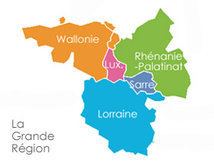 | ||
What is the greater region
The Greater Region (French: Grande Région, German: Großregion, Luxembourgish: Groussregioun) is the area of Saarland, Lorraine, Luxembourg, Rhineland-Palatinate, Wallonia and the rest of the French Community of Belgium, and the German-speaking Community of Belgium. It is not identical with the SaarLorLux Euroregion, despite being in the same territory.
Contents
- What is the greater region
- Kufa s urban art greater region
- Geography
- European Capital of Culture
- Museums and temporary exhibitions
- History
- Tourism
- Interreg program
- References
It is situated between the Rhine, Moselle, Saar and Meuse rivers, has an overall area of 65,401 km². Its population counts 11.2 million inhabitants, representing 2.5% of the total population of the 27-state European Union, and accounting for the same proportion of the EU GDP.
The Greater Region is divided between Romance and Germanic languages and also forms the hub for transport in Europe. It has an urban, rural (Ardennes-Eifel-Rheinhessen) and industrial fabric which is the source of rich and ongoing economic and cultural relations.
Kufa s urban art greater region
Geography
The size of the Greater Region is more than 400 km from East to West and more than 350 km from North to South.
"11.2 Millions of people live in the Greater Region; this is corresponding to 3% of the total population of the 15 European Union member states. In the same dimension the Greater Region contributes to the gross domestic product of the community. (...) All four member states are faced with economic challenges, being subject to changes in their industrial and mining industries. So they create a certain syndicate to cope with these problems, like the "European Development Pool of the sectors Longwy (France), Rodange (Luxembourg), Athus (Belgium)".
European Capital of Culture
In 2007 Luxembourg and the Greater Region, together with city of Sibiu, Romania, were designated by the European Union for a period of one year to be the European Capital of Culture, during which they were given a chance to showcase their cultural life and cultural development.
Museums and temporary exhibitions
In the Greater Region more than 1,200 museums and other institutions present and conserve the heritage of this core European region.
History
The history of the Greater Region and its subdivisions is a mirror of the History of Europe starting from the prehistory up to the current European history. Outstanding testimonials of all European eras can be retrieved in the area of the Greater Region. Due to the Romanization during ancient Roman times and the invasion of the Germanic people during the Late Antiquity, the Greater Region became a threshold region up today. Hence the cultural, historical, political, economical and social inhomogeneities shape the region and its inhabitants until today. Several wars, like the Four Lords' War, and foremost World War I with the Battle of Verdun and World War II with the Battle of the Bulge, the Maginot Line and the Siegfried Line devastated the region. Today, peaceful forms of coexistence, like the numerous cross-border commuters, may be seen.
Tourism
The Greater Region contains many interesting tourist destinations. In general, they can be reached in day trips from any starting point within the Greater Region. The following are the major tourist destinations in the area:
Interreg program
The Greater Region is supported by Interreg III, a Community initiative which aims to stimulate interregional cooperation in the EU between 2000-06. It is financed under the European Regional Development Fund (ERDF).
This phase of the Interreg initiative is designed to strengthen economic and social cohesion throughout the EU, by fostering the balanced development of the continent through cross-border, transnational and interregional cooperation.
The current INTERREG IV A Greater Region (Grande Région) programme (period 2007 - 2013) has been elaborated to enforce the cooperation between the project partners from the different parts of the Greater Region.
